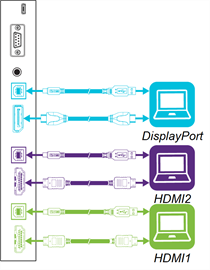Connecting power, cables and devices
Connect the interactive flat panel to power after you install it but before you turn it on for the first time. You can also connect cables for room computers, guest laptops or other input sources as well as for speakers and room control systems.
By installing cables in advance, you make use of connectors that might not be accessible after the interactive flat panel is wall-mounted. You can then run the cables across floors or behind walls as needed.
Warning
Ensure that any cables that cross the floor to the interactive flat panel are properly bundled and marked to avoid a trip hazard.

Connect the supplied power cable from the AC power inlet on the bottom of the interactive flat panel to a power outlet.
Note
Refer to the interactive flat panel’s specifications for power requirements and power consumption information (see About your interactive flat panel).
Note
By default, the HDMI output extends the Windows desktop, and this can cause display problems in certain configurations. If you experience issues, set the HDMI out to a mirrored desktop rather than the default extended desktop. Right click, select Display settings, and set the secondary display to mirror the first.
Tip
You can connect peripherals, such as a keyboard or mouse, to the Intel Compute Card using the USB receptacles on the iQ appliance.
You can connect cables to the interactive flat panel so that users can connect and use room computers, guest laptops or other devices, such as Blu-ray disc players.

The interactive flat panel includes up to three sets of computer connectors:
DisplayPort: This set of connectors can accommodate a USB cable for touch control and a DisplayPort cable for video and audio.
HDMI 2: This set of connectors can accommodate a USB cable for touch control and an HDMI cable for video and audio.
HDMI 1: This set of connectors can accommodate a USB cable for touch control and an HDMI cable for video and audio.
SMART recommends the following varieties of cable:
Cable type | Maximum length | Recommendations |
|---|---|---|
23' (7 m) 1 | Use only certified HDMI cables that have been tested to support the performance standard you require. | |
23' (7 m) | Use DisplayPort 1.2 compliant or better cables. | |
16' (5 m) | Use a USB extender if the distance between the computer and the interactive flat panel is greater than 16' (5 m). For more information, see USB extenders. |
Using cables that exceed these maximum lengths may produce unexpected results, degraded picture quality or degraded USB connectivity.
SMART software should be installed on any computers users connect to the display. For information on installing SMART software and viewing a connected computer’s input on the display, see Connecting and using computers.
The interactive flat panel includes two 10 W speakers, which are designed to provide sound at the front of a room. You might want to connect the SBA-100 projection audio system (see Accessories) or third-party external active speakers if you’re providing sound in a larger space.

You can connect external speakers to the interactive flat panel using the stereo 3.5 mm out connector (pictured). Alternatively, you can connect external speakers directly to a room computer.
A room control system enables users to control a room’s lighting, audio system and, possibly, the interactive flat panel. Some installations may require you to integrate the interactive flat panel with a room control system.
You can use the interactive flat panel’s RS-232 connector to connect a third-party external control system to the interactive flat panel (see Remotely managing your interactive flat panel).
Note
Interactive flat panels are not compatible with centralized remote control systems, such as a universal remote control.
The following diagram and table present the connectors on the interactive flat panel’s connector panel:
SBID8055i‑G5 and SBID8065i‑G5 |
SBID8065i‑G5‑V2 and SBID‑8075i‑G5 |

